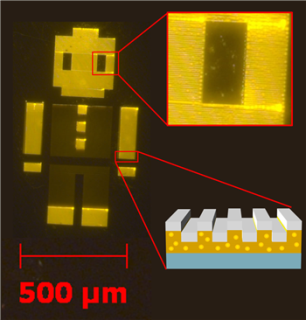Aug 11 2015
Researchers from the University of Illinois at Urbana-Champaign have been involved in creating a new technique that can extract highly efficient and polarized light from quantum dots (QDs) over a large-scale area.
 To demonstrate their new technology, researchers fabricated a novel 1mm device (aka Robot Man) made of yellow photonic-crystal-enhanced QDs. Every region of the device has thousands of quantum dots, each measuring about six nanometers.
To demonstrate their new technology, researchers fabricated a novel 1mm device (aka Robot Man) made of yellow photonic-crystal-enhanced QDs. Every region of the device has thousands of quantum dots, each measuring about six nanometers.
QDs can be defined as nano-sized semiconductor particles capable of generating bright, distinct, color light. QDs have moved from being merely used in research labs to commercial items such as high-priced TVs, laptops, e-readers, and even certain types of LED lighting.
However the fact is these QDs are expensive to produce and hence the need to develop QDs at reduced fabrication costs, and better performance and efficiency is gaining momentum.
The Illinois team’s novel technique integrates QD and photonic crystal technology, and is a probable option for the creation of highly efficient and brighter mobile phone, computer displays, tablet and enhanced LED lighting.
The team was headed by Brian Cunningham (ECE), Ralph Nuzzo (chemistry), and Andrew Alleyne (MechSE) and their research was funded by the Dow Chemical Company. They embedded QDs in unique polymer materials which possessed strong quantum effectiveness.
Next they applied electrohydrodynamic jet (e-jet) printing technology to accurately print the QD-embedded polymers onto photonic crystal structures. This process is done with precision, thereby preventing wastage of QDs, which are costly to produce.
Photonic crystals restrict the direction of QD-generated light emission. In other words they generate polarized light, which is highly intense than regular QD light output.
According to Gloria See, an ECE graduate student and the lead author of the research stated in Applied Physics Letters, that their replica molded photonic crystals are likely to pave the way for brighter, more efficient and less expensive displays in the future. “Since screens consume large amounts of energy in devices like laptops, phones, and tablets, our approach could have a huge impact on energy consumption and battery life,” she noted.
“If you start with polarized light, then you double your optical efficiency,” See explained. “If you put the photonic-crystal-enhanced quantum dot into a device like a phone or computer, then the battery will last much longer because the display would only draw half as much power as conventional displays.”
To illustrate the technology, See created an innovative 1mm device, which is also referred to as Robot Man, comprising yellow photonic-crystal-enhanced QDs. The device is made up of thousands of QDs, with each QD measuring around six nanometers.
“We made a tiny device, but the process can easily be scaled up to large flexible plastic sheets,” See said. “We make one expensive ‘master’ molding template that must be designed very precisely, but we can use the template to produce thousands of replicas very quickly and cheaply.”
Other members of the Illinois research team include chemistry graduate student Lu Xu, who performed the polymer-QD mixing, and MechSE graduate student Erick Sutanto, who performed the e-jet printing.